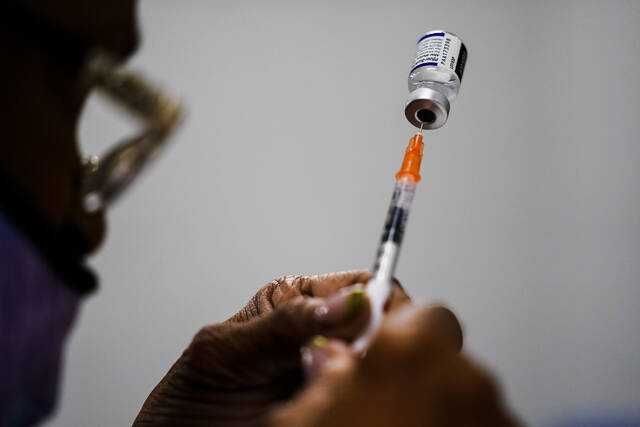Editorial: Vaccines work and vaccine waste is a tragedy
In December 2020, the nation breathed a collective sigh of relief when the day that had been awaited for nine months finally arrived.
The first covid-19 vaccines were delivered to hospitals across the country. The first vaccines were delivered into the arms of some of the most at risk: front-line medical workers, who were contracting covid because of the bombardment of relentless exposure, and the sick and elderly, who were vulnerable and dying.
For more than 18 months, Pennsylvanians have been receiving the vaccine as the gates opened to more and more groups of people. Those with respiratory conditions such as asthma. The overweight. Inmates and corrections officers. Teens. School children. Most recently, the vaccine has been OK’d for kids under 5.
About 70% of the Keystone State’s residents are fully vaccinated, and 44% have received at least one booster. That’s about 23 million doses that made it from bottle to needle to arm.
Unfortunately, 2.2 million didn’t make it that far.
According to the state Department of Health, that’s how many doses have been wasted.
We aren’t talking about just wanton destruction or epic clumsiness. This isn’t about hundreds of thousands of bottles that have been misplaced. Sure, some bottles were broken. Some others were lost. Accidents happen.
But the data show most of those undelivered doses were because of spoilage.
That’s to be expected to a certain degree. The vaccines are temperature-sensitive. The Pfizer vaccine required super-cooling for transportation and storage. The Moderna and Johnson & Johnson vaccines were a little more forgiving, but it was still a factor. The Centers for Disease Control and Prevention has a 70-page handbook on how to handle the vaccines properly, warning that not maintaining the “vaccine cold chain” could affect the potency, resulting in additional shots and increased costs.
But some of the spoilage can happen even when all that happens perfectly — because it’s all in the timing.
The vaccines have to be used in a 12-hour period. That means 20 shots of Moderna in that period or six of Pfizer. If a Moderna vial was opened at 8 a.m. and only one shot was given per hour all day, by 8 p.m., eight doses are going in the trash. The state’s vaccination clinic lost 4,891 doses to vials not used completely.
At the height of vaccine distribution, when it was hard to find appointments and some people were going outside the county or even the state if necessary, that wasn’t as much of a factor. As the pandemic seemed to be less of a problem and the world got back to normal, appointments freed up. Fewer appointments meant vials didn’t get used as quickly. Others went to waste because of no-shows.
But infectious disease expert Dr. Amesh Adalja puts part of the blame on an issue that didn’t start with the coronavirus pandemic but was exacerbated by it.
“The amount of waste is emblematic of how deep the anti-vaccine movement has reached,” he said.
That’s sad to see in the backyard of Dr. Jonas Salk, the man behind the polio vaccine. It’s also sad to see the first U.S. case of polio in about a decade recently pop up in New York. The patient is an unvaccinated adult.
Vaccines have been saving lives for generations. They work, and the more people get them, the better they work. And a vaccine in the arm always works better than one in the trash.
Remove the ads from your TribLIVE reading experience but still support the journalists who create the content with TribLIVE Ad-Free.

